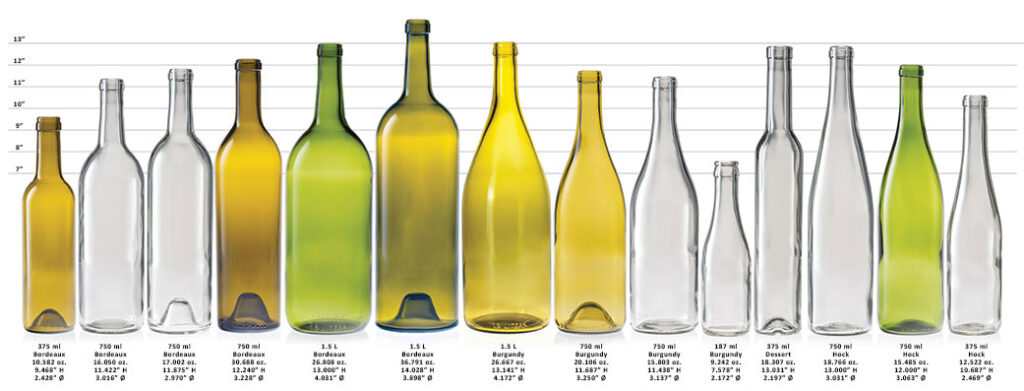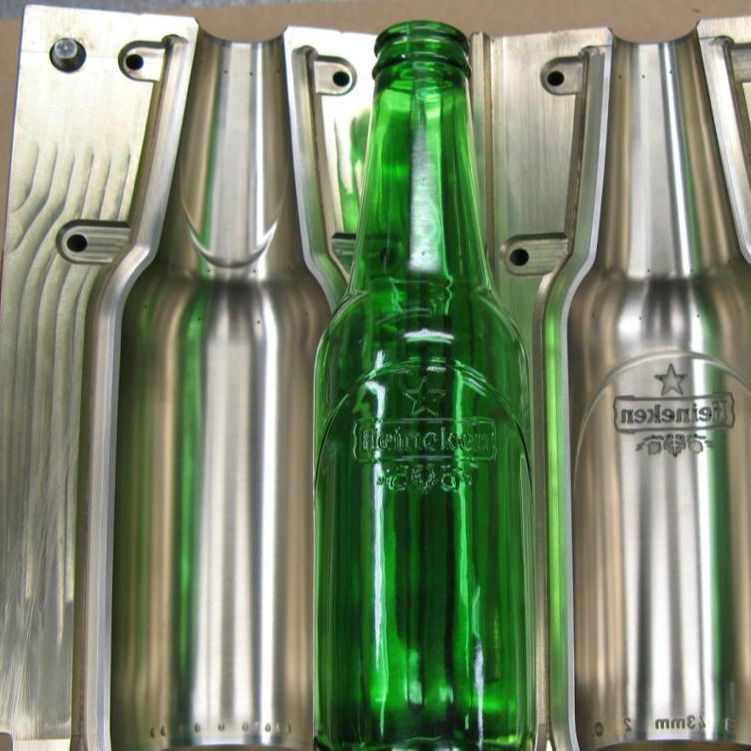Most glass bottle manufacturers receive various quality issues from customers every year, causing complaints and losses for both parties. Many foreign trade companies and start-up factories do not control quality or solve problems, but instead pass the responsibility. These are all quality issues, which are mainly caused by improper quality control in the production process. In this article, we will discuss some common quality issues and provide solutions.
- Mold Inspection:
Most manufacturers of glass wine bottles use molds provided by customers or new molds based on drawings or sample bottles. Key dimensions that affect molding must be communicated and negotiated with customers in a timely manner before the mold is opened, and opinions on key dimension revisions must be agreed upon. This has a crucial impact on the product yield and molding effect. In some cases, some newly graduated drawing designers are not familiar with the factory’s machines and may draw drawings based on their own ideas, ignoring the reality of the machines.
Our solutions for molds include:
- To prevent mold design errors, our designers have been in the industry for more than 30 years, fast in drawing, reasonable in design, and high in product yield. If you need free design, you can contact us.
- All molds must be checked for compatibility of the mouth mold, initial mold, final mold, and various parts when they enter the factory. Reducing errors is ensuring delivery time.
- Molds are not consumables and can be used for a long time. Before and after production, we have dedicated personnel to regularly apply rust-proof oil to the molds to prevent mold damage and facilitate future use. At the same time, we only charge customers a one-time mold fee for the same type of mold. If the mold’s service life is reached or it is damaged due to uncontrollable factors, whether it is the cost of maintenance or re-manufacturing the mold, we will pay for it and will not charge customers multiple mold fees.
- Sample Inspection:
Before the mold starts production, 10-30 products called samples will be produced. Our QC will sample 2-3 products from each mold and check their appearance, gloss, weight, capacity, size specification, including internal and external diameter, and whether the engraving on the bottom of the bottle is correct and clear, and whether the pattern or logo on the bottle is correct.
- If the customer purchases lids at the same time, we will use matching lids to test the assembly and matching of the bottle and the sealing performance. If necessary, we will also test the internal pressure, internal stress, and acid and alkali resistance of the bottle.
- Process Inspection:
Because the mouth mold is easy to be covered with oil during application, it can cause the problem of loose lid and leakage. Our QC will clean the mouth mold every half an hour. Under the condition that the mold is not replaced, our QC will sample 2 bottles from each group of molds every 2 hours for capacity and weight testing, and also test the internal and external diameter of the mouth. - Our QC will rotate to inspect the quality of bottles on each production line, especially after replacing molds. Because the early molds need to be preheated after replacement, the quality of bottles produced during this time is not good, and all bottles produced during this period will be scrapped. We have been in the industry for more than ten years and have never made mistakes in this regardFull Inspection:
-
- After the products come out of the production line, the quality inspectors must first conduct a comprehensive inspection of the appearance of all bottles. The inspection items include:
(1) Bubbles on the bottle: Bubbles are a common problem in glass bottles. Most quality inspectors cannot accurately grasp the size, for example, bubbles larger than ∮1mm are not allowed on the sealing surface of the bottle mouth, and there should be no more than 6 bubbles within 1 square centimeter with a diameter of less than ∮1mm. For bubbles with a diameter of 1mm < ∮ < 6mm, there should be no more than 3 bubbles with a distance of at least 20mm between them. It is difficult to grasp, so we have introduced advanced X-ray detection machines. The machine will automatically identify and judge whether the bottle is qualified. If it is qualified, it will continue to move forward on the production line and wait for packaging. If it is not qualified, it will be directly scrapped, becoming raw materials without wasting or polluting, with a 0% misjudgment rate.
(2) Crooked neck: Even if it does not affect the match with the cap, it affects the overall appearance of the bottle. The reason for this is mostly due to the misalignment of the mouth mold and the forming mold, or one side of the mouth mold is not completely placed on the forming mold. This can be solved by our engineers correcting it manually.
(3) Slanted bottom: The uneven flow of glass liquid at the bottom of the forming mold due to low glass liquid temperature can cause one side to be thicker and exceed half, affecting the weight and reducing the product level. This situation mostly occurs shortly after changing the mold, because the mold needs to be preheated, so it will absorb the temperature of the glass liquid, causing the temperature to drop. As mentioned earlier, all bottles during the period after changing the mold will be scrapped, so these bottles will not be packaged.
(4) Diameter of the seam line: The seam line with a diameter larger than 0.5mm, or with a scratchy feeling, is not allowed, especially if this occurs above the bottle mouth. The main reason is that the forming mold is not in place or worn out, and needs to be repaired, polished, and assembled. This situation generally occurs when changing the mold, and at this time, only the mold needs to be adjusted or replaced.
(5) Color of the material: In general, the color of the raw materials will not change significantly, unless the proportions of the various components of the raw materials change, which will cause the bottle to appear blue or green. Other companies adjust the proportions of the various components of the raw materials. The proportion of raw materials in each factory is confidential. Because we have more than ten years of production experience, our approach is to adjust the proportion of raw materials before production starts. Because of our expertise, we have not encountered cases of bottle discoloration in more than ten years.
(6) Inner and outer diameter of the bottle mouth and the appearance of the concave on the inner side of the bottle mouth: This is a common problem with the bottle mouth. Outer diameter: The mouth mold is prone to oil stains during use, which can cause the anti-slip teeth to become smaller, and the cap to slide left and right, not tight enough. If a concave appears on the inner side of the bottle mouth, the inner plug of the cap cannot be tightly plugged, which will cause leakage. The main reason is that the glass liquid is too soft, and the speed of drawing the core after the glass liquid enters the initial mold can be manually controlled, which is caused by the glass liquid not being completely formed; or the core is too short, and can be appropriately lengthened to solve the problem.
(7) Off-center bottom (the bottle is skewed): The main reason is that the glass liquid is too hot and has not cooled completely after molding. The glass liquid has not cooled completely, and is affected by gravity, causing the bottle to tilt downwards. It may also be caused by the molded product not being placed in the center of the bottom.
(8) Thin shoulder: This is a common problem with flat-shoulder glass bottles. This is due to the design of the mold. Before the product is packaged, we will gently tap the shoulder part with a rubber hammer during the inspection process to detect problems and make timely adjustments.
(9) Dull bottle body: The bottle body has many irregular spots and looks hazy, with poor transparency. This is mainly because after the mold is released during molding, there is a layer of carbide on the inside and outside, which can be polished and treated.
(10) Rough material: There are many rough spots on the bottle body. The main reason is that the furnace temperature is too low, the glass liquid is not completely melted, or the feeding machine is too fast. The speed can be reduced and the output can be reduced, and measures can be taken to ensure the temperature of the molten material in the furnace. - Incoming inspection:
The quality management personnel stop sampling the waste products that have been packaged and are waiting to be put into storage according to the AQL sampling plan. When sampling, try to sample from all aspects (upper, middle, and lower parts). The inspection should be carried out strictly according to the specifications or customer requirements. Qualified products should be put into storage immediately, neatly stacked, and clearly marked. For non-conforming batches, they must be marked, isolated, and sent back for rework until they pass the inspection.
- After the products come out of the production line, the quality inspectors must first conduct a comprehensive inspection of the appearance of all bottles. The inspection items include:
- Sixth, Inspection of Flower Decal Processing on Glass Bottles:
- Red color reversal: The main reason is that the glass liquid temperature is too high and the mesh belt speed is too slow, which causes the added decolorizing agent to stop the restoration reaction.
- Poor adherence of flower decal: Apart from the material of the flower decal itself, this is mainly caused by low temperature. Due to the different materials of the flower decal, different temperatures are required during the flower decal baking process. Therefore, engineers with many years of work experience need to adjust the temperature and other settings during the flower decal baking process, so that the products can be produced quickly and steadily.
- Blisters on the flower decal: For bottles baked in a high-temperature furnace, there are many holes on the flower decal, which is caused by the fact that the air bubbles inside the flower decal were not brushed away after the flower decal was applied, or the moisture on the surface of the flower decal was not dried before baking. For products that have already been baked but are not up to standard, they can be scraped off with dilute hydrochloric acid and re-baked after applying a new flower decal.
- Mixing of products with different styles: Since the bottle shape is exactly the same, different parameters need to be used on the flower decal to distinguish between different styles. Some small factories or trading companies, in order to meet delivery deadlines, will produce different types of bottles on the same production line, which will lead to mixed packaging. In order to avoid this situation, we will produce on different production lines to avoid confusion.
- Glass bottle production and processing may not be considered high-tech, but it is closer to the user than high-tech products such as chips. Before customers come into contact with your product, they will come into contact with your product’s packaging. Good packaging can not only improve the purchase rate of your product, but also increase its value. There is a Chinese saying that goes, “A good horse with a good saddle.” Good products also need to be matched with good packaging. Click here to get your free samples and free design.
Post time: 5月-12-2023








